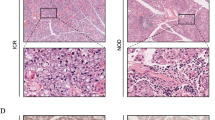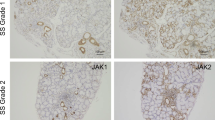Abstract
Background
Sjögren’s Syndrome (SS) is also known as autoimmune exocrine gland disease. Previous studies have confirmed that adaptive immunity plays an important role in the development of this disease. But less is known about the role of the innate immune system.
Methods
To identify the core pathways, and local infiltrated immune cells in the local immune microenvironment of SS. We verified the activation of these core genes and core signaling pathways in SS model mice by in vivo experiment and transcriptome sequencing.
Results
Finally, we identified 6 core genes EPSTI1, IFI44L, MX1, CXCL10, IFIT3, and IFI44. All the 6 genes had good diagnostic value. Based on multi-omics sequencing results and experimental studies, we found that cGAS–STING signaling pathway is most relevant to the pathogenesis of SS. By in vivo experiments, we verified that autophagy is the key brake to limit the activation of cGAS–STING signaling pathway.
Conclusions
Maladaptive activation of autophagy and cGAS–STING signaling pathway are central contributors to the SG pathogenesis of pSS patient. Regulating autophagy by rapamycin may be a possible treatment for Sjögren's syndrome in the future.













Similar content being viewed by others
Data availability
All the datasets used in the present research are summarized in the Additional file.
References
Björk A, Mofors J, Wahren-Herlenius M (2020) Environmental factors in the pathogenesis of primary Sjögren’s syndrome. J Intern Med 287(5):475–492
Bodewes ILA, Versnel MA (2018) Interferon activation in primary Sjögren’s syndrome: recent insights and future perspective as novel treatment target. Expert Rev Clin Immunol 14(10):817–829
Colafrancesco S, Barbati C, Priori R et al (2021) Maladaptive autophagy in the pathogenesis of autoimmune epithelitis in Sjӧgren's Syndrome. Arthritis Rheumatol 74(4):654-664
de Neergaard M, Kim J, Villadsen R et al (2010) Epithelial-stromal interaction 1 (EPSTI1) substitutes for peritumoral fibroblasts in the tumor microenvironment. Am J Pathol 176(3):1229–1240
Fox RI, Fox CM, Gottenberg JE et al (2021) Treatment of Sjögren’s syndrome: current therapy and future directions. Rheumatology (oxford) 60(5):2066–2074
Hillen MR, Pandit A, Blokland SLM et al (2019) Plasmacytoid DCs From Patients With Sjögren’s Syndrome Are Transcriptionally Primed for Enhanced Pro-inflammatory Cytokine Production. Front Immunol 10:2096
Horvath S, Nazmul-Hossain AN, Pollard RP et al (2012) Systems analysis of primary Sjögren’s syndrome pathogenesis in salivary glands identifies shared pathways in human and a mouse model. Arthritis Res Ther 14(6):R238
Huijser E, Bodewes ILA, Lourens MS et al (2022) Hyperresponsive cytosolic DNA-sensing pathway in monocytes from primary Sjögren's syndrome. Rheumatology (Oxford) 61(8):3491-3496
Jara D, Carvajal P, Castro I et al (2021) Type I Interferon Dependent hsa-miR-145-5p Downregulation Modulates MUC1 and TLR4 Overexpression in Salivary Glands From Sjögren’s Syndrome Patients. Front Immunol 12:685837
Kim D, Langmead B, Salzberg SL (2015) HISAT: a fast spliced aligner with low memory requirements. Nat Methods 12(4):357–360
Langfelder P, Horvath S (2008) WGCNA: an R package for weighted correlation network analysis. BMC Bioinformatics 9:559
Lessard CJ, Li H, Adrianto I et al (2013) Variants at multiple loci implicated in both innate and adaptive immune responses are associated with Sjögren’s syndrome. Nat Genet 45(11):1284–1292
Li B, Dewey CN (2011) RSEM: accurate transcript quantification from RNA-Seq data with or without a reference genome. BMC Bioinformatics 12:323
Love MI, Huber W, Anders S (2014) Moderated estimation of fold change and dispersion for RNA-seq data with DESeq2. Genome Biol 15(12):550
Manoussakis MN, Kapsogeorgou EK (2010) The role of intrinsic epithelial activation in the pathogenesis of Sjögren’s syndrome. J Autoimmun 35(3):219–224
Mavragani CP, Moutsopoulos HM (2020) Sjögren’s syndrome: Old and new therapeutic targets. J Autoimmun 110:102364
Mielle A, Tison A, Cornec D et al (2019) B cells in Sjögren's syndrome: from pathophysiology to therapeutic target. Rheumatology (Oxford) 60(6):2545-2560
Mitsias DI, Kapsogeorgou EK, Moutsopoulos HM (2006) The role of epithelial cells in the initiation and perpetuation of autoimmune lesions: lessons from Sjogren’s syndrome (autoimmune epithelitis). Lupus 15(5):255–261
Moutsopoulos HM (1994) Sjögren’s syndrome: autoimmune epithelitis. Clin Immunol Immunopathol 72(2):162–165
Mowat C, Mosley SR, Namdar A et al (2021) Anti-tumor immunity in mismatch repair-deficient colorectal cancers requires type I IFN-driven CCL5 and CXCL10. J Exp Med 218:9
Odani T, Chiorini JA (2019) Targeting primary Sjögren’s syndrome. Mod Rheumatol 29(1):70–86
Oyelakin A, Horeth E, Song EC et al (2020) Transcriptomic and Network Analysis of Minor Salivary Glands of Patients With Primary Sjögren’s Syndrome. Front Immunol 11:606268
Papinska J, Bagavant H, Gmyrek GB et al (2018) Activation of Stimulator of Interferon Genes (STING) and Sjögren Syndrome. J Dent Res 97(8):893–900
Pertea M, Pertea GM, Antonescu CM et al (2015) StringTie enables improved reconstruction of a transcriptome from RNA-seq reads. Nat Biotechnol 33(3):290–295
Pontarini E, Lucchesi D, Bombardieri M (2018) Current views on the pathogenesis of Sjögren’s syndrome. Curr Opin Rheumatol 30(2):215–221
Pontarini E, Murray-Brown WJ, Croia C et al (2020) Unique expansion of IL-21+ Tfh and Tph cells under control of ICOS identifies Sjögren’s syndrome with ectopic germinal centres and MALT lymphoma. Ann Rheum Dis 79(12):1588–1599
Sjöstrand M, Ambrosi A, Brauner S et al (2013) Expression of the immune regulator tripartite-motif 21 is controlled by IFN regulatory factors. J Immunol 191(7):3753–3763
Sun JL, Zhang HZ, Liu SY et al (2020) Elevated EPSTI1 promote B cell hyperactivation through NF-κB signalling in patients with primary Sjögren’s syndrome. Ann Rheum Dis 79(4):518–524
Szklarczyk D, Gable AL, Lyon D et al (2019) STRING v11: protein-protein association networks with increased coverage, supporting functional discovery in genome-wide experimental datasets. Nucleic Acids Res 47(D1):D607-d613
Tasaki S, Suzuki K, Nishikawa A et al (2017) Multiomic disease signatures converge to cytotoxic CD8 T cells in primary Sjögren’s syndrome. Ann Rheum Dis 76(8):1458–1466
Verrou CKM, Piperi E et al (2021) Interferon (IFN)-stimulated gene 15: A novel biomarker for lymphoma development in Sjögren’s syndrome. J Autoimmun 123:102704
Wang B, Chen S, Zheng Q et al (2021) Early diagnosis and treatment for Sjögren’s syndrome: current challenges, redefined disease stages and future prospects. J Autoimmun 117:102590
Yu G, Wang LG, Han Y et al (2012) clusterProfiler: an R package for comparing biological themes among gene clusters. OMICS 16(5):284–287
Zhang F, Mears JR, Shakib L et al (2021) IFN-γ and TNF-α drive a CXCL10+ CCL2+ macrophage phenotype expanded in severe COVID-19 lungs and inflammatory diseases with tissue inflammation. Genome Med 13(1):64
Acknowledgements
We thank the Institute of Pediatrics of Nanjing University of Chinese Medicine for its experimental support and research facility.
Funding
This work was supported by the National Natural Science Foundation of China (grant 82274454) and the Postgraduate Research & Practice Innovation Program of Jiangsu Province (KYCX21_1682).
Author information
Authors and Affiliations
Contributions
WZ, YBW performed the experiments, conducted the Major data analysis, and finished the original draft. YG, YHL, and YL all wrote the manuscript and prepared figures. LXS and YW designed this study and finished the revision of the manuscript. All authors have read and approved the final manuscript.
Corresponding authors
Ethics declarations
Conflict of interest
No potential conflict of interest was reported by the author(s).
Additional information
Publisher's Note
Springer Nature remains neutral with regard to jurisdictional claims in published maps and institutional affiliations.
Supplementary Information
Below is the link to the electronic supplementary material.
Rights and permissions
Springer Nature or its licensor (e.g. a society or other partner) holds exclusive rights to this article under a publishing agreement with the author(s) or other rightsholder(s); author self-archiving of the accepted manuscript version of this article is solely governed by the terms of such publishing agreement and applicable law.
About this article
Cite this article
Zhu, W., Wang, Y., Guan, Y. et al. Rapamycin can alleviate the submandibular gland pathology of Sjögren's syndrome by limiting the activation of cGAS–STING signaling pathway. Inflammopharmacol 32, 1113–1131 (2024). https://doi.org/10.1007/s10787-023-01393-9
Received:
Accepted:
Published:
Issue Date:
DOI: https://doi.org/10.1007/s10787-023-01393-9




